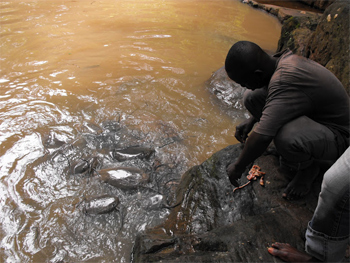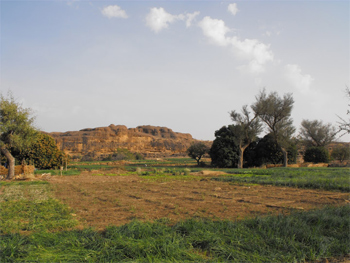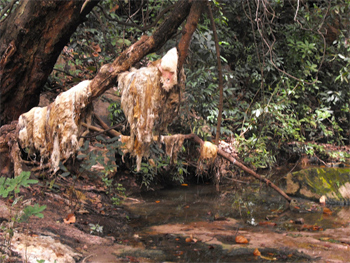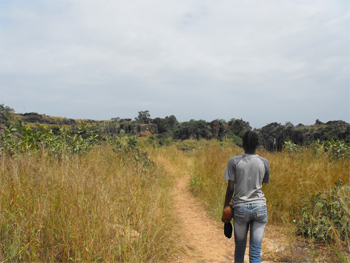
By Jonathan David Thompson
Our beaten, blue, diesel Mercedes crept gently down the muddy road. It slowed every ten or fifteen feet to allow one or both of the front tires to drop into one of the many deep, water-filled gouges that were scattered about the road.
Dry millet and corn stalks leaned over to brush their yellow heads on the windshield as we passed, and Kenny Roger’s was singing, “You got to know when to hold ‘em, know when to fold ‘em,” on the stereo set to Radio Bobo.
We’d met our guide, Emilie, the night before at a small open-air bar near the Sitarail train station in downtown Bobo-Dioulasso, the second largest city in Burkina Faso. On first take, Emilie looked more like a Brooklyn college student than a West African adventure guide: she approached our table in high heals, tight blue jeans, and a fake Versace purse strung over her shoulder.
Though her appearance was far from the rugged, khaki raiment, and Merrill boots that my girlfriend and I have grown to expect of our West African guides, Emilie cut straight to business. We discussed the prospects of traveling outside Bobo-Dioulasso (or Bobo as the locals call it) to see the Sacred Fish of Dafra the next day, and agreed on the price of 30.000 CFA (about $60 American) for the two of us, all included. She told us that we’d start the next morning.
An Early Start
Morning starts early in Burkina Faso. She picked us up at our hotel at 7:00 AM in her fatigued, yet clean, early 90’s Mercedes. En route out of town, we stopped at group of Muslim men perched on a line of wooden benches that ran parallel to the road. They wore floor-length, fully embroidered robes, and brightly colored taqiyah hats rested on their cleanly shaven heads. The two large, wooden crates that separated their benches from the road were loosely packed with squawking, flappable chickens.

Emilie informed us that we would need to purchase two chickens (one per person) to be killed, gutted, and sacrificed to the sacred fish. As we climbed from the car, one of the men delicately wrapped his prayer beads around his fingers and rose to greet us.
“Bonjour,” I said to him. He responded in a language I didn’t understand. “Comment ça va?” I tried again. No response.
Emilie came in and bargained for the chickens with just a few quick phrases, and handed the man 3.000 CFA (About $6 American) for the two birds. The man grabbed the two chickens from the crate and handed them to me. I held them upside-down by the legs as Emilie opened the trunk of her car and told me to place the two birds inside.
We continued down the dirt road for a few minutes before stopping at a small cluster of mud homes near the side of the road. We entered through an opening in the mud wall, and found ourselves in a small, courtyard-esque, space that was enclosed by interlocking mud homes. A large iron caldron sat on an open fire in the center of the space, bubbling over with a maroon colored liquid that Emilie informed us was dolo, a local millet beer.
A Bottle of Dolo
Emilie purchased a liter bottle of dolo that would also be used in the sacrifice, and we tasted some of the thick liquid from a calabash that the woman tending the fire gave to us. The texture was chalky, almost grainy, but the flavor was close to the homemade hard apple cider that my New England friends used to make in college each fall. We climbed back into her car and left town.

The road that leaves town was roughly cut. It wove indiscriminately over shallow outcrops of jagged rock and between clusters of waist-deep grass. The field quickly gave way to a mango grove where onion beds laid in the sunlight that fell between the branches, and Kenny Rogers continued crooning on the radio. Emilie turned the volume louder.
“You like this song?” I asked her.
“Sometimes this radio station, Radio Bobo, plays music that I don’t understand,” she said. “I don’t know what he’s singing about. I don’t speak English, but this music is good.”
Hearing Kenny Rogers sing the “The Gambler” at that moment — creeping through the savanna in the back seat of an old diesel Mercedes, watching Burkinabé bush-farmers till their onion fields with nothing but a hand-wielded hoe, powered naught by oil, but by the exhaustive dips and rises of their shoulders driving the handmade instrument into the rich, dark earth — was one of the more uncanny cultural clashes I’ve experienced in any of my travels, anywhere on Earth. Fortunately, I didn’t have too long to dwell on the surrealism abound.
Emilie parked the car at a farmer’s hut by the side of the road.
“It’s too wet to drive through here,” she told us.
To the Sacred Fish

With chickens and dolo in hand, we continued on foot down the unundated road. We crossed a brisk, ungodly clear stream, and ascended a dry plateau that carried us over several weather-terraced rock faces. Our descent into the water-carved canyon of the sacred fish was abrupt and steep.
Emilie smacked her daba (gardening hoe) against the tree trunks we passed to alert the fish of our presence. The temperature dropped, and the smell of damp feathers, raw flesh, and wood smoke filled the air as we continued down into the canyon.
We arrived to see ten or twelve men diligently depluming dead chickens on the large stone clearing that flanked the river’s waterfall-fed pool. Ancient, vine-draped Sahélien hardwoods shaded the area. Their lower branches were covered by an array of wet goat pelts. Women rubbed shea butter on the rocks nearby, and pools of chicken and goat blood mixed with disposed feathers on the sacrifice platform. We removed our shoes and joined the men near the river.
“Only the chosen Bobo (Bobo is the ethnic group that dominates the region), who are initiated and chosen by God are allowed to sacrifice here,” Emilie told us. A man in a faded black t-shirt approached us as she spoke. “This man will sacrifice for you,” Emilie said. “You’ll make your wishes through him.”
Sacrificing the chickens
Emilie handed the man our two chickens and poured some of the dolo into a calabash, which we each held while making our wishes. The man then splashed the dolo over a blood-covered stone ledge, mumbled several rapid phrases, and cut each chicken’s throat. He tossed the chickens into a stone pit to fight off rigor mortis, then deplumed and eviscerated both of them, saving only the intestines in his hand while placing the meat on a spit over the fire.

We climbed down from the sacrificial platform to a lower pool that was teeming with countless three to five foot long catfish. Sensing our movement on the rocks, the goliath fish approached with their mouths gaping. They lurched and twisted toward us, leaping skyward as we drew near.
The water in the pool quickly turned turbulent as the man held the chicken intestines over the water and the fish leapt and wriggled over each other in competition of the sacrificial snack. Their thick, black whiskers whipped over the rocks where we stood and their fins crashed tumultuously as more catfish joined the pile of chaos.
The feeding frenzy lasted about three minutes. As soon as the intestines were finished, our pooled portion of the river returned to its murky calm. We climbed back up toward the sacrificial platform, and the man who had sacrificed the chickens continued to cook them over the fire. We retrieved our sandals and poured the remaining dolo in a calabash for him to drink.
How We Pay Him
“This is how we pay him,” Emilie explained. “He can’t accept money for sacrificing to the sacred fish, so we give him chicken meat, and the left over dolo.”
We exited the sacrificial platform, and Emilie led us out of the canyon. We traversed the dry rock terraces, crossed the ungodly clear stream (which I then realized was one of many small streams that fed the river that housed the sacred fish), and ambled down the muddy road to Emilie’s car.
My girlfriend climbed into the front seat, and I sat in the back. Emilie put the beaten, blue, diesel Mercedes in gear and we slowly crept back out onto the meandering, muddy road. The staunch scent of onion greens filled the car as we passed through the mango grove, and Emilie turned the stereo on to Radio Bobo. We drove back into the city with country music in our ears, hoping that our wishes would come true.

Jonathan David Thompson travels when he can travel and writes when he can write. He lived and worked in West Africa for two years as a Peace Corps volunteer, and has trotted other parts of the globe extensively. He currently lives in New England.
- These 9 U.S. National Parks Require Reservations in 2024 - April 17, 2024
- Take a Hike in Olympic National Park - April 17, 2024
- The Wild Mississippi: 2340 Miles Across Ten States - April 8, 2024

